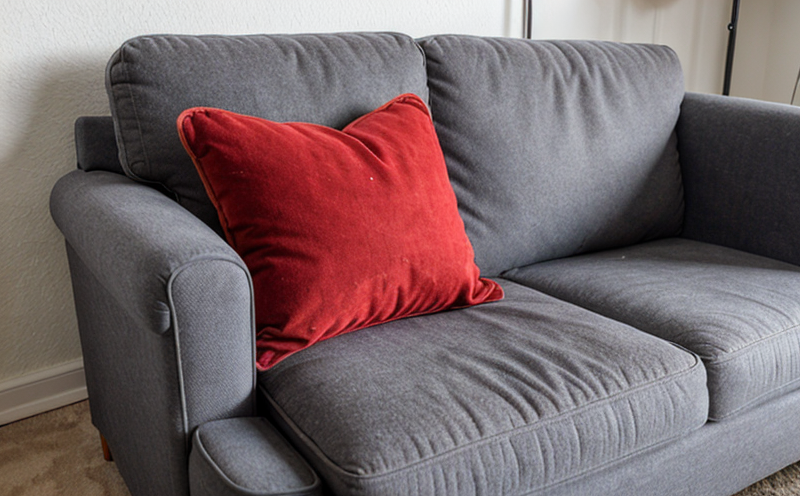ISO 5402 Flex Resistance of Upholstery Leathers Testing
The ISO 5402 test method is a critical standard for evaluating the durability and flexibility of upholstery leathers. This test assesses how well the leather can withstand repeated bending or flexing motions, which are common in high-use furniture like chairs and sofas. The primary focus is on ensuring that the material maintains its appearance and structural integrity over time.
The test simulates real-world conditions by replicating the repetitive motion of a person sitting down and standing up repeatedly. This ensures that the leather can endure prolonged use without cracking, splitting, or losing its original shape. Upholstery leathers are not only important for their aesthetic appeal but also for their durability, making this testing essential.
The test involves placing a strip of the material under tension and bending it back and forth over a specific angle at predetermined intervals until failure occurs. The number of cycles to failure is recorded as a measure of the leather's flex resistance. This quantitative data allows manufacturers to compare different materials and identify those with superior performance.
During specimen preparation, it’s important that the leather strips used for testing are representative of the final product. This includes ensuring uniform thickness and texture across all specimens. The test apparatus used in ISO 5402 is designed specifically for this purpose, providing consistent results every time.
The acceptance criteria for this standard specify that a minimum number of cycles must be achieved before failure to pass. Compliance with these standards ensures that the product meets industry expectations and can withstand the rigors of everyday use. This testing is particularly crucial in sectors such as furniture manufacturing where customer satisfaction relies heavily on material durability.
Understanding the significance of this test helps quality managers, compliance officers, R&D engineers, and procurement professionals make informed decisions about their materials selection process. By adhering to ISO 5402, manufacturers can ensure they are delivering high-quality products that meet both aesthetic and functional requirements.
Why It Matters
The durability of upholstery leathers is directly linked to the longevity and satisfaction of end users. By ensuring that the materials used in furniture can withstand repeated bending without damage, manufacturers enhance customer trust and loyalty. This not only improves brand reputation but also reduces the need for frequent replacements, leading to cost savings over time.
Compliance with ISO 5402 is essential for furniture companies aiming to meet regulatory standards and industry best practices. It ensures that products are consistent in quality across different batches and production lines. This consistency is vital for maintaining a uniform product line and meeting customer expectations.
The test also aids in the development of new materials and designs by providing data on how various leathers perform under stress. Engineers can use this information to innovate, creating more resilient and appealing products that stand the test of time. Additionally, it supports sustainability efforts by encouraging the use of durable, long-lasting materials.
For procurement teams, ISO 5402 provides a clear benchmark for selecting suppliers who meet high standards of quality. This ensures that all components used in furniture assembly are reliable and can contribute to overall product performance.
Quality and Reliability Assurance
ISO 5402 testing is integral to the quality control process for upholstery leathers. By incorporating this test into their manufacturing workflow, companies can identify potential issues early in the production cycle. This proactive approach allows for corrective actions before large quantities of substandard materials are used.
The test results provide detailed insights into the flex resistance capabilities of different leather types and finishes. These data points help quality assurance teams make informed decisions about which products to recommend or reject. For instance, if a particular leather consistently fails to meet the required number of cycles before breaking, it might be necessary to explore alternative suppliers or modify production processes.
Regular ISO 5402 testing also fosters continuous improvement within manufacturing plants. By tracking trends in test results over time, companies can identify areas for enhancement and implement changes that improve overall product quality. This iterative process ensures that each new batch of leather undergoes stringent scrutiny before being incorporated into finished products.
From a reliability perspective, adherence to this standard guarantees consistent performance across all products. Regardless of where the furniture is sold or installed, consumers can expect the same level of durability and satisfaction from their purchases. This consistency builds trust between manufacturers and customers, reinforcing brand loyalty and fostering long-term relationships.
Environmental and Sustainability Contributions
- Reduces waste: By ensuring that upholstery leathers can withstand repeated use, this testing helps minimize the need for frequent replacements. This reduces the amount of waste generated by furniture manufacturers.
- Promotes resource efficiency: The test encourages the use of durable materials, which in turn promotes efficient resource utilization throughout the product lifecycle.
- Encourages sustainable practices: Compliance with ISO 5402 aligns manufacturing processes with broader sustainability goals, contributing to more eco-friendly production methods and end products.
The emphasis on durability through rigorous testing also supports circular economy principles by extending the life cycle of furniture. This reduces environmental impact by decreasing raw material consumption and energy use associated with producing new items.
Furthermore, the test helps manufacturers make informed choices about sustainable materials that contribute positively to both environmental conservation and social responsibility. By prioritizing flex resistance in their product development process, companies can create products that not only look good but also perform well over extended periods without compromising on aesthetic appeal or functionality.





